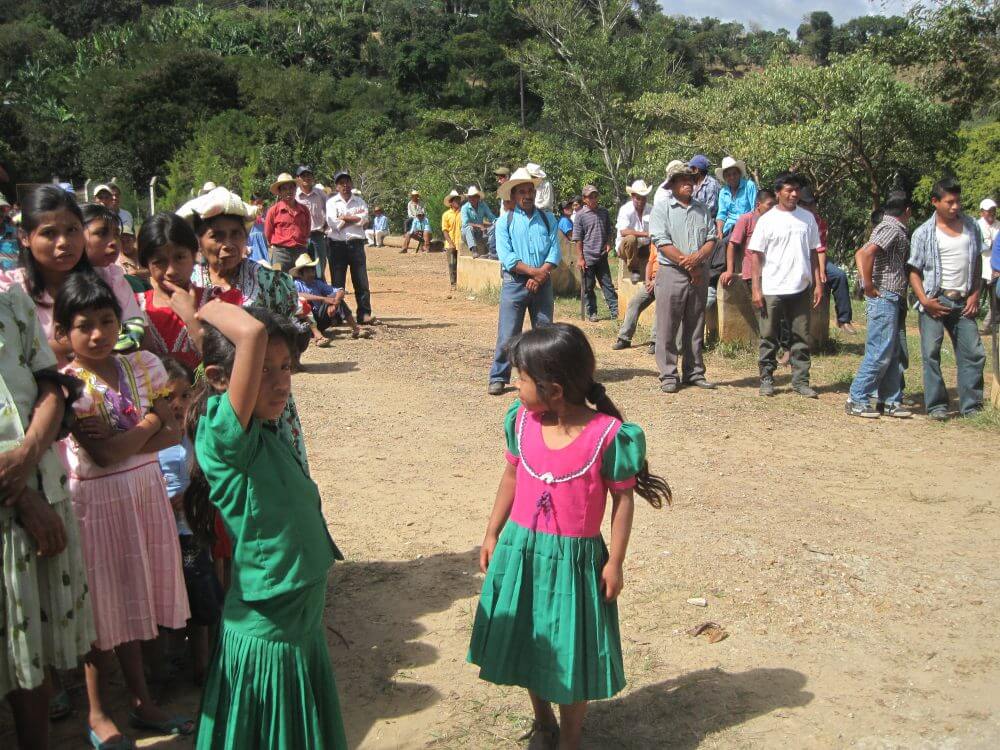
In Copán Ruinas everybody comes to see the ancient Maya ruins. Declared a World Heritage Site by UNESCO, the area is famed for its remarkable sculptures and hieroglyphics. Lonely Planet describes it as the place where the Maya, “lived, prospered, then mysteriously crumbled.” But are the Maya really a thing of the past? Being Maya Ch’ort’i certainly appears to be a complicated issue. While most Ch’ort’i are marginalized and ashamed of their roots, their name and identity has been co-opted and their culture has become an exhibition. Other Ch’ort’i do not sit back idly. A battle against a planned mining project has opened the door to the past, leading to the assertion of Ch’ort’i identity in an effort to recover their culture and reclaim their ancestral land.
Ever heard of the town of Copán Ruinas? If you’ve ever travelled to Honduras, the chances are good that you went there before visiting the famous nearby Maya ruins.
The Copán archaeological site is the most visited tourist attraction in the country. Declared a World Heritage Site by UNESCO, the area is famed for its remarkable sculptures and hieroglyphics, Lonely Planet describes it as the place where the Maya, “lived, prospered, then mysteriously crumbled… These days you’ll often be virtually alone at the site, which makes it all the more haunting.
Whether you visit the archaeological site, tour a local museum, seek out a hotel or restaurant, or just go for a casual stroll through the town, you get the distinct impression that the Maya Civilization really is a thing of the past–that the Maya themselves are all dead and gone.

A Maya Ch’ort’i community in Guatemala. Photo: Frauke Decoodt
If you’ve heard of the Ch’ort’i, you know that it’s not true. One of the seven indigenous peoples in Honduras, the Ch’ort’i are in fact Maya. Honduras counts around 38.500 Ch’ort’i, living in the northwestern departments of Copan and Ocotepeque. Even more Ch’ort’i reside in southeastern Guatemala and northern El Salvador. Centuries ago their ancestors ruled these lands and built the magnificent civilization that so many tourists now come to admire.
These days, the Ch’ort’i are the most marginalized inhabitants of the region. Many tourists, like the backpacker in my hotel, are completely surprised to hear that an indigenous population still inhabits the area. My sympathetic hotel host, similar to many locals living in the town, downplay their existence, their numbers, their “indigenousness”.
The Spanish invaders did a great job erasing the Maya and their rich culture. The Ch’ort’i suffered a particularly cruel and tough persecution: They were expropriated from their lands, enslaved and forced to accept a new language, religion, dress, and housing. The policy of assimilation and marginalization continued with the formation of the Honduran State. Consequently, the Ch’ort’i lost much of their ancestral knowledge, traditions and spirituality. In Honduras only a few still speak their native language. Most Ch’ort’i live in villages mixed with a mestizo population. With the exception of a few women you could not differentiate Ch’ort’i by their dress from other local Hondurans.
But does their colonial experience make them less indigenous? Are the Maya in this area really just a thing of the past? It doesn’t help that locals minimize their continued existence and appropriate their name while many Ch’ort’i refuse outright to identify with their kin.
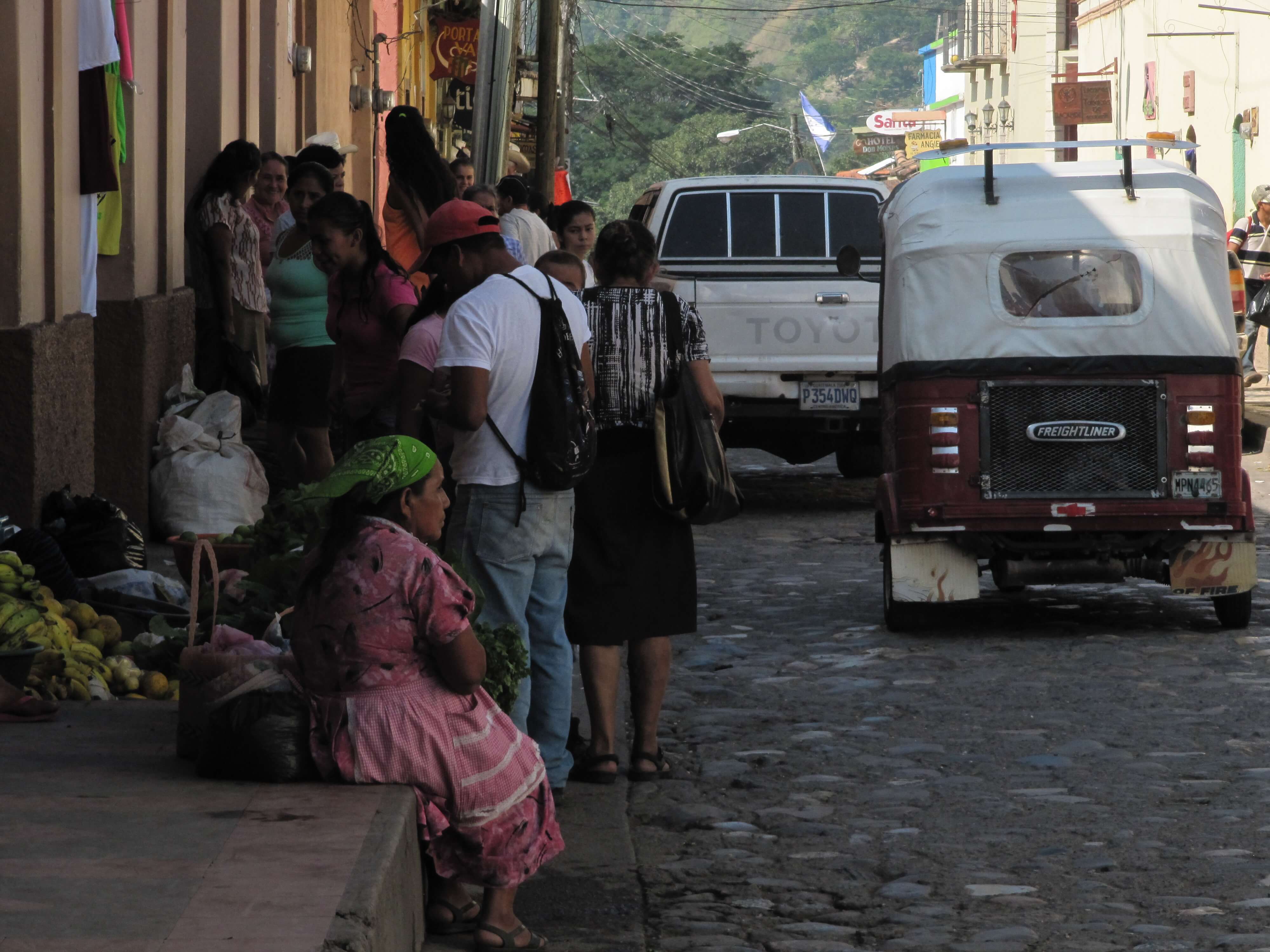
Women in the streets of Copán Ruinas. Photo: Frauke Decoodt
“In town some people say that the Maya do not exist anymore. But if one goes to the surrounding communities one sees a different reality. Many Ch’ort’i still live there,”says Juan Manuel Peres, a longtime Ch’ort’i community leader. “Being Ch’ort’i does not depend on the colour of your skin or the way you dress. It is something you feel inside, in your heart. It is about sharing our worldview, our practices and beliefs.”
I visit Mr. Peres at home without prior notice but after putting on a clean shirt he gladly makes some time. His wife keeps busy doing the many household chores, his children alternate between playing around and curiously listening to what their father has to say.
Juan Peres denounces the marginalization of the Ch’ort’i the appropriation of their name for commercial purposes. “Others fill their pockets with our name and culture. We don’t see a dime from the revenue made from our ceremonial grounds, the famous ruins of Copán. The hotels, the restaurants, the municipality call themselves Maya-this or Ch’ort’i-that. Even the military police and mining company appropriated our name. Meanwhile so many of our people have nothing. Nothing to eat, nowhere to build our home, no land to grow our corn. Outside town people are suffering hunger”.
Antonio Arras couldn’t agree more. Antonio is the coordinator of one of the two local Ch’ort’i political organizations, CONADIMCHH. He made some time for me on his free Sunday so I ran straight from the bus to the organization’s office, a simple room with two old computers and a fan. “Our culture became a business, we became an exhibition. One of the tourist attractions for example is a visit to a Ch’ort’i community, La Pintada, where little barefoot children with their corn-leaf dolls sing you the national anthem in our native language. Meanwhile there is no real acknowledgement of our culture, no indigenous representation in the local council or government support programs. Hardly any Mayans work in the local businesses that carry our name.” The lack of acknowledgement sometimes goes to extremes. “Every now and again we hear about studies, even from government institutions that aim to determine if we really are indigenous.”
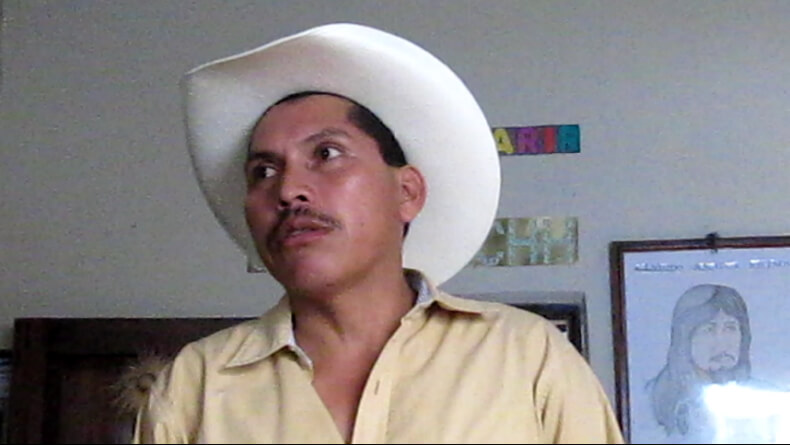
Antonio, the coordinator of CONADIMCHH. Photo: Frauke Decoodt
The denial of the specific Ch’ort’i reality ironically reflects itself in the curious observation that most people I talk with, even a local government functionary, consider themselves ‘descendants of the Mayas’ and can therefore claim an indigenous identity. Many Ch’ort’i on the other hand appear ashamed of their indigenous identity and consider themselves mestizos. “They do not want to accept they are indigenous” Antonio tells me. “We eat the same, we share the same wordviews, you can see their culture in them. But they feel they are mestizos like the rest of society. They scorn us.”
Although culture is a changing thing and some of the ancestral culture remains, the century long marginalization and assimilation has obviously leave scars on the Ch’ort’i identity. The Ch’ort’i I speak to lament their loss of culture.
But they haven’t just lost much of their culture. The Ch’ort’i lost have also lost ownership of their ancestral land.
Recovering their land and culture is what the struggle of the Ch’ort’i is all about. One fight cannot exist without the other.
“An Indian without land is a dead Indian” both Juan Peres and Antonio Arras tell me. Antonio adds, “Land is what guarantees our identity, our survival.”
Ever since the Spanish colonizers invaded their lands the Ch’ort’í mounted sporadic acts of resistance. In 1995 that resistance revived. Both Pedro and Antonio dedicated most of their adult life to it. They tell me about the struggle of the Ch’ort’i to recuperate their land, their culture and identity. In that struggle their opponents criminalized, imprisoned and murdered their kin that dared to organize. Eventually the Honduran State promised the Ch’ort’i 14,700 hectares in 1997. As of today they’ve only received 4500 hectares of that land—and that land is unproductive and difficult to cultivate.
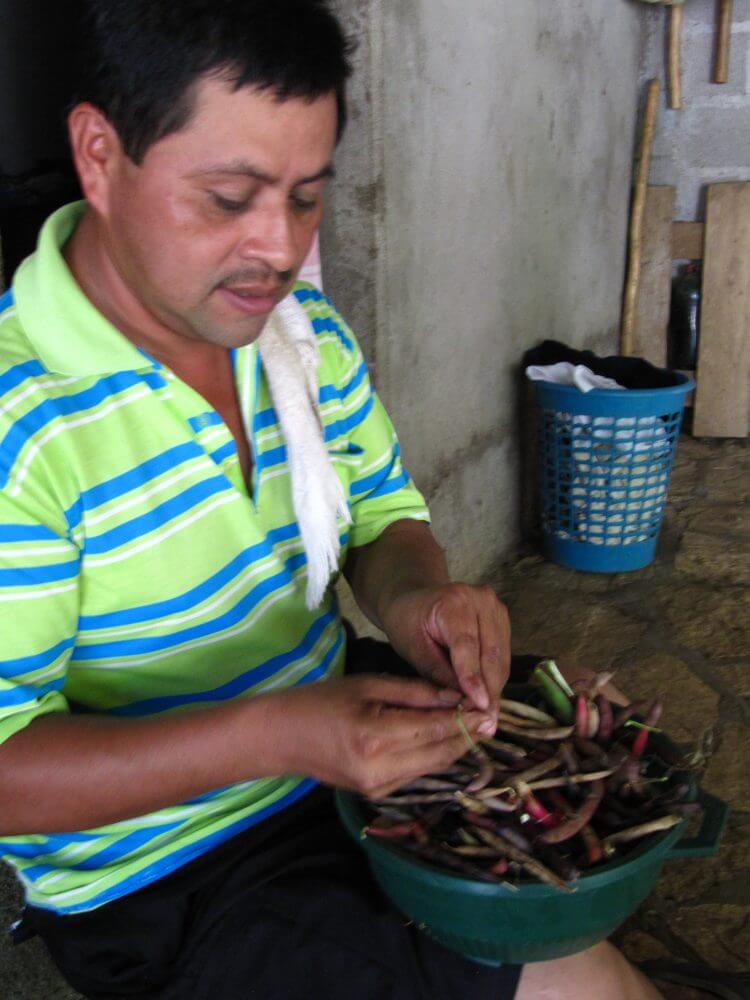
Pedro, a long time Ch’ort’i community leader. Photo: Frauke Decoodt
Most locals, urban and rural, rich and poor, bluntly negate the Maya claim to their ancestral territory even if powerful landlords own much of these lands. However,, local respect for the Ch’ort’i and their fight to recuperate their land and culture may be turning around because of the possible arrival of what Antonio declares another colonial enterprise, a mining company called Minerales Chorti S.A. In September 2015 this company was granted permission to explore 2819 hectares of the region for minerals, gold it is rumoured. On this side of the world mining ventures aren’t usually beneficial to local populations, let alone the environment. Antonio’s organization CONADIMCHH stands on the frontline of the resistance against this mining venture. They joined forces with the local water committees who together with other concerned citizens established ‘Copan Ruinas Environmental Coalition’. In this battle against the mining project assertion of Ch’ort’i identity has become a crucial tool. A resurgence and pride of Ch’ort’i identity is a direct consequence of this resistance.
Rode Murcia is the coordinator of the Environmental Coalition. She receives me at her office, a small room beside the energetic family’s living room. “Before, many communities did not feel the need to organize themselves. Lots of people here lost their traditions. The prospect of a mine in our territory led many however to question their reality, the surrounding power relations and our history, it made many value their roots. One of our battle goals is that locals recognize their cultural identity, perceive the importance and value of saying ‘I am Maya, I am indigenous’.”
The awareness raising effort obviously had results. I visited the mestizo community El Quebracho, one of the villages that may be affected by the mining project. As evening falls I sit down with six men in the community yard, but one of them does most of the talking. “We do not consider ourselves a Ch’ort’i community but now that we start organizing against this mining project we became to see ourselves as descendants of the Maya. We realize we are all one and united. Before we scorned the Maya, now we are proud of our origins.”
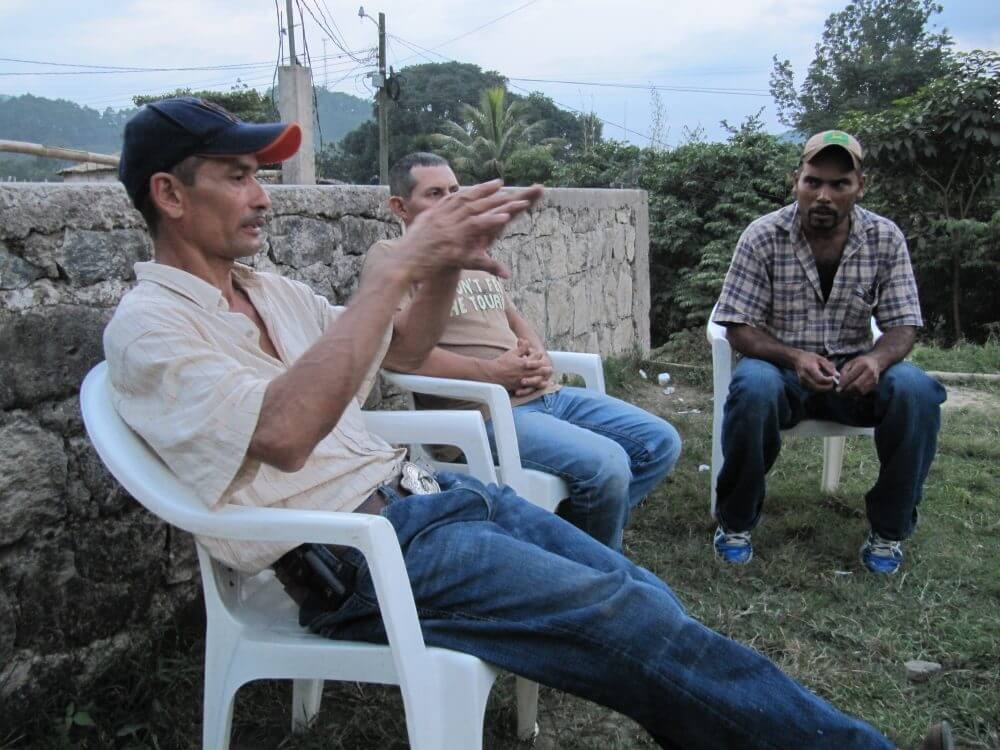
Talking with the men in El Quebracho. Photo: Frauke Decoodt
Asserting indigenous identity is also a strategic choice of resistance. Environmentalists and human rights activists argue the national Honduran mining law mainly serves mining companies. An international agreement from the International Labor Organization, number 169 to be exact, does however serve the rights of indigenous and tribal peoples. It includes a statement that indigenous peoples should be previously consulted and informed about development projects in their territories “with the objective of achieving agreement or consent to the proposed measures”. Honduras ratified the legally-binding agreement in 1995.
“As indigenous people, as Maya Ch’ort’i, we call upon our right to be consulted,” affirms Antonio. It is Rode that provides me an insight into the relevance of identity as a tool in this struggle. “It does not suit the government to recognize us as indigenous people because they know that, according to Treaty 169, this gives us rights.” Locals revaluing themselves as indigenous people, something the organized Ch’ort’i have long fought for, became a weapon of resistance.
The concessions for exploration of metals are there. But there’s no telling what will happen in the future. The Honduran government might grant concessions for exploitation. The local resistance may turn the whole mining project into a tempest in a teapot. In any event, there’s no turning back the increase in cultural consciousness, the pride in a Maya ancestry and identity. It is the first step to a resurgence of one’s traditions, a re-appropriation of ancestral worldviews, a reliving of one’s identity. Who knows, right now locals stand united as one against the mining project, maybe in the future they will stand united as one in the struggle for Ch’ort’i land and culture.
You can find more stories by Frauke Decoodt at her blog.

Indigenous Peoples are putting their bodies on the line and it's our responsibility to make sure you know why. That takes time, expertise and resources - and we're up against a constant tide of misinformation and distorted coverage. By supporting IC you're empowering the kind of journalism we need, at the moment we need it most.